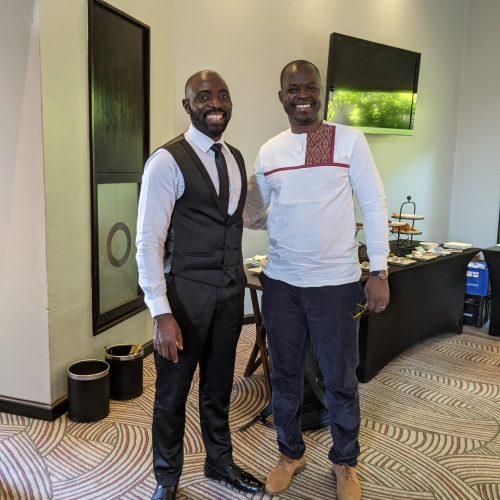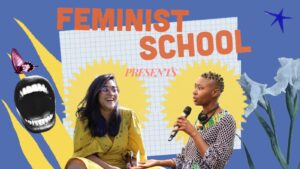This is the eighth blog post of the AI Research and COVID: Journeys to Gender Equality and Inclusion series. This blog series emerged from the “writeshop” organized by Gender at Work as part of the Data Science and Artificial Intelligence Research Program to Combat COVID-19, also known as AI4COVID, financed by the International Development Research Centre (IDRC) and Swedish International Development Cooperation Agency (SIDA). The initiative was part of the final Gender Action Learning workshop held in Nairobi, Kenya in February 2023.
In this blog post, Tidiane Ndoye shares how his experiences nurtured his passion for gender issues in health, and his role as a lead gender expert in the AI4COVID research project, Using artificial intelligence to combat COVID-19 in Senegal and Mali. He reflects on being a mentor of master’s and PhD students and to the broader research team. He raises the critical need for gender and intersectionality in applying AI to address the COVID pandemic to avoid reinforcing inequalities, particularly for women from marginalized groups.
Find this blog in its original language – French – here.
Asking Questions about using AI in the fight against Covid-19?
Over a two-year period (2021–2023), with colleagues from various universities and independent researchers from three countries, I have been conducting research into the impact of the COVID-19 pandemic on communities in several African countries, specifically Mali and Senegal. The aim was to examine the use of artificial intelligence (AI) in the fight against COVID-19, and more specifically its social adaptability and acceptability. The question was whether the application of AI considers the ethical dimension.
In its formulation, the project integrated a gender lens. We wanted to be as inclusive as possible in the composition of the team. We had 4 post-graduate grants, which we chose to give to 2 master’s students (one woman and one man) and 2 PhD students (one woman and one man).
I remember that AI was a new issue for us, coming as we did from the social sciences. We called in experts to strengthen our knowledge of AI, which was very beneficial to our work going forward.
We had some core questions that we wanted to ask communities directly, and to see the differences between men and women, young and old. Within the team, we started asking ourselves questions about the translation of a few key terms that we were going to use in this research, particularly when asking the communities. For example, how do you translate artificial intelligence for people who hadn’t been to school, for people who didn’t even have a smartphone and had a distant relationship with technology? Were they concerned by AI? Could we exclude them or was it important to include them?
For the social scientists involved in the project, this question of unequal access between social categories was a core issue requiring a gender analysis. As the person who had previously worked on gender analysis, I was tasked to deal with the gender dimensions, which I had put on the back burner since my master’s thesis on ‘the impact of women’s economic status on family roles and well-being.’ Early on in my career, I had a strong inclination towards feminist studies.
Gender marked me: Becoming a gender specialist in the research project
My family history meant that I was very much inspired by my mother, who was always keen for me to study hard and not give in to the easier, shorter routes. She was a very hard worker, even though she didn’t have the chance to study, and she wanted her children to follow their dreams. My mother’s character inspired me to work on the status of women.
But I soon became disillusioned, lonely as I was, as a man, in a field dominated by women. In my experience, gender issues are of more interest to women researchers.
At forums focused on gender issues, I was one of the few men present. I gradually got the idea that I was working in an environment where women were all-powerful, and questions about my future professional development led me to reorientate myself towards the social anthropology of health, a no less interesting field that seemed to me to be more mixed, with men and women working in it having more or less equal chances of obtaining research grants and scholarships.
So in the early 2000s I turned my attention to health, which is also an eminently ‘gendered’ field. In many countries, health issues are linked to the gendered distribution of social roles, and the significant presence of women in health facilities and roles in caring for the sick (both children and the elderly) is a palpable reality.
So gender stuck with me.

The problem: Students with no gender capacity
But let’s get back to the question of my appointment as gender specialist on this project. I very quickly discovered that the students recruited and involved in the project had not been taught about gender.
How can the project succeed if the people directly involved in it are not trained to see and analyse gender issues? How could the issues that would arise be resolved? We therefore needed to train them in gender analysis to involve them more closely in the construction of questionnaires and other interview guides, and also to integrate gender-specific aspects into their master’s and PhD work in sociology.
It was at this point that we seized the opportunity offered by the Gender at Work group to enable the team to learn more about the current pressing gender issues. The team took part in a number of sessions enabling everyone to take better account of the issues of being a woman or a man that were reflected in the measures taken by the political authorities to contain COVID-19.
From virtual learning and taking a deeper dive on gender, we first learned that restrictive measures (semi-confinement, curfews, restrictions on travel between regions, border closures, etc.) have prevented many women and men from having access to resources to look after their families. This is the case of women who used to trade in border areas, restaurant managers, etc. We also observed that women, who play a major role in meeting family expenses, have seen their role called into question. Men who stay at home have also seen their status as providers of resources affected.
The skills acquired through virtual learning and the sharing of documentary resources subsequently enabled us to place the students at the centre of the process in constructing the survey questionnaires and interview guides. They then played a central role in training the interviewers recruited for data collection in the field.
This experience showed that building the skills of students and future leaders (scientists in universities, in development projects, etc.) was a central need for research in Africa.
On this basis, the Senegal team decided to set up a project, with the support of the Gender at Learning process, titled ‘To-in-form’. In this project, we decided to share our research results with other groups of graduate students ― outside the team ― to show them the value of our approach of involving women and analysing data from a gender perspective. The dual purpose of this approach was to inform and to educate.
We wanted to show that each student (informed and trained) could pass on what they had learned to other audiences (family, university, workplace, etc.), and we also realized that they could play a role in raising awareness of issues around gender and intersectionality. It was important to recognise that sometimes the compounding effects of various inequalities ― such as being a woman, a female head of household, or travel restrictions for women ― could occur at the intersection of several affiliations (by occupation, neighborhood, income level, etc.).
What we learned so far
Looking back, I was pleased to see that the students involved in the project integrated gender aspects into the analysis of the results as part of their master’s degree. For those who are still doing their theses, this approach is central to their thinking.
For the broader cohorts of students that we engaged, their interest in gender issues was notable for discovering the richness of disaggregating data and re-examining lives ― ‘real lives’ ― behind the aggregation of data and the sometimes-impersonal measures taken to contain COVID-19.
Artificial intelligence often excludes less educated groups such as women, who cannot use Internet tools (chatbot, search, etc.). In addition, its use in actions to support affected populations as part of social policies may also exclude the least visible categories, including women. Women may not be the primary recipients of state aid during a pandemic, even though they are often heads of household or among the main providers of resources in normal times. All of this can generate exclusions that AI can reinforce if particular attention is not paid to these factors.
At the current stage of the project, the next step is to start sharing the results of the research with decision-makers and other stakeholders (researchers, feminists, actors interested in AI or gender, or both, etc.). The hope is to learn from these stories how best to build a response to epidemics that will undoubtedly be a reality in the future: the distant future or the near future? Who knows?
This blog post was written by Tidiane Ndoye & is licensed under a CC BY 4.0 license. © 2023 Tidiane Ndoye.
Tidiane Ndoye is a socio-anthropologist with expertise in health issues, particularly malaria, gender and health, resilience, and pandemics, and a lecturer at Cheikh Anta Diop University, in Dakar since 2011. His publications cover a wide range of topics, from malaria to the laws governing the practice of traditional medicine in Africa, to reproductive health, tuberculosis to COVID-19.
Curious to read more reflections on AI, gender inequality and exclusions? Read the first blog posts from this series here: Amelia Taylor’s Can AI have its cake and eat it too?, Michelle Mbuthia’s Cook, Clean, Plan: A case for more gender-responsive policymaking, Meghan Malaatjie’s Are women programmed to think less and do more?, Jim Todd’s Break out of your silo, Mahlet Hailemariam’s Why are you talking to a blank screen?, Sylvia Kiwuwa Muyingo’s A Biostatistician’s Personal Journey through Gender Bias, and Ethan Gilsdorf’s No Differences, Only Sames: Finding Common Ground in Nairobi During the AI4COVID Gender Action Learning Writeshop.



